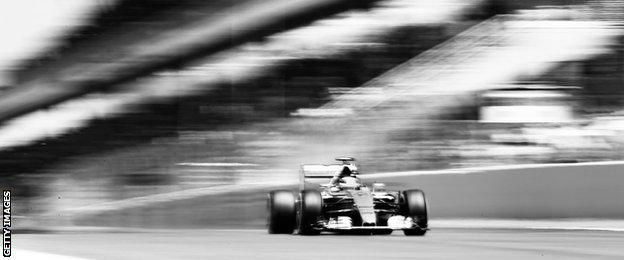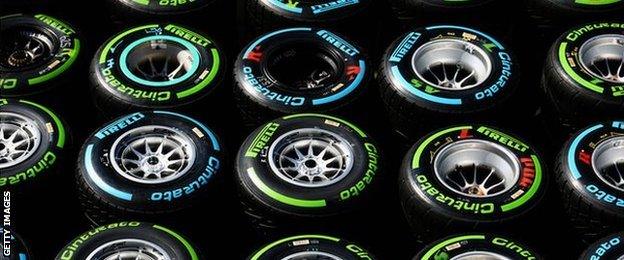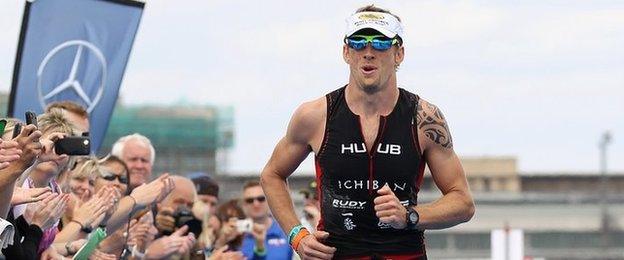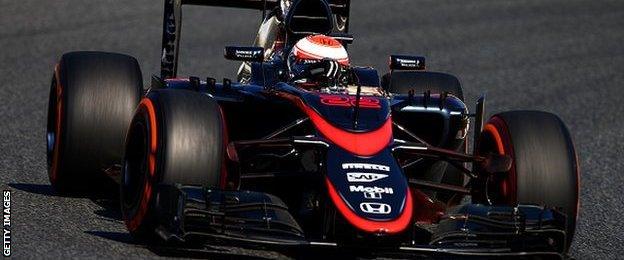David Coulthard column: 'Slow cars disillusion F1 drivers'
- Published
By David Coulthard, BBC F1 co-commentator and former F1 driver |
The Spanish Grand Prix was not exactly the most exciting Formula 1 race there has ever been, and that has inevitably revived the debate about whether F1 needs some form of surgery to recover some magic.
This is a hot topic in F1 - the teams are meeting this week for the latest discussions over whether to change the rules for 2017 to make the cars more exciting and spectacular.
I don't pretend to have a magic formula, and I don't want this to be seen as 'my agenda to fix F1'. It is not that at all.
But I do have some views on the state in which F1 finds itself, and I do believe there are areas in which it could be improved.
Speed

Today's average F1 car can reach speeds of more than 200mph
In my view, the current era of F1 should always be pretty much the fastest period of the sport in history.
Technology advances. We're used to mobile phones getting lighter, doing more things, having better battery life, more capacity. The 100m world record gets ever lower. Man goes further and longer into space. Yet in F1 the cars are several seconds slower than they were 10 years ago.
Of course there are a number of reasons for that. There is no competition between tyre manufacturers. Refuelling was ditched five years ago. The cars were slowed down for safety reasons.
Some people would argue that the cars cannot go on getting faster and faster because they would eventually get too fast for the circuits.
I'm not so sure about that. Look at Monaco, the next race. We have been racing around there since the 1920s, and we will continue to do so until a car clears the catch fencing and ends up perched in a grandstand somewhere.
Hopefully that day will never come, but as any parent who has seen their small child fall over and hurt themselves knows, you cannot take all the danger out of life.
Of course it is unacceptable not to make F1 as safe as it can be, and we should be using technology to do that.
But danger will always be there in a sport in which men race projectiles at more than 200mph. And I think it is fundamental that the DNA of F1 should be: "Wow! Did you see how fast they are?"
They might not say so publicly, but I know that the current drivers are all a bit disillusioned with the current F1 because the cars are so slow compared to previous years, and the drivers are so far within their ability levels during the races.
You watch the in-car camera through somewhere like Turn Three in Barcelona. That should be right on the edge, heart in mouth, nearly flat-out, like it was a few years ago. Now they all have to take a massive lift through there.
The other day I was voicing some commentary from the 2000 French Grand Prix, which I won after angrily gesticulating at Michael Schumacher because his driving had annoyed me.
The cars looked properly fast. Of course, F1 still looks quick. But the difference was quite striking.
Tyres

Each driver has access to 13 sets of dry-weather tyres, four sets of intermediate tyres and three sets of wet tyres
You will very rarely hear them saying it publicly but, without exception, no-one in F1 likes the construction and compound range of the current tyres, and people are very negative about Pirelli as a result; hardly good PR.
I have no doubt that, if challenged to do so, Pirelli could build much racier tyres.
The bosses of the sport do not want a tyre war between different manufacturers, but I I don't understand why. After all, there are chassis wars and engine wars.
As long as the boundaries were set out - no testing, limits on costs to teams - there is no reason why a tyre war would have to have cost implications.
The tyres are clearly part of the problem of the lack of overtaking in F1 at the moment. They are so sensitive. There is so much tyre management.
While I am commentating, I find it very difficult not to be exasperated when Mercedes suddenly go a second quicker than they have been when they need to do it.
The drivers I know who compete in the World Endurance Championship, where they use Michelin tyres, tell me that they push on every single lap through a 24-hour race. This sometimes involves using just one set of tyres for two or even three 45-minute stints.
That's great for them, but it used to be what I was doing when I drove in F1. The only time you backed off was if you were in the final stint of the race and you had a 20-second lead or something.
Now, it is the other way around, and the times the drivers are completely on the limit during a grand prix are a small minority. Sometimes they never are.
A corollary of this is that if the drivers are not pushing, they are far less likely to make a mistake. You don't see so many as you used to. And mistakes add excitement.
The physical challenge

Jenson Button is a keen triathlete and has raised money for cancer research via his own triathlon trust
There was a time not so very long ago when F1 was physically and mentally exhausting for the drivers. That is no longer the case.
For any normal human being, the cars would still be impossibly tough to drive. But F1 drivers are finely-honed athletes of the highest calibre and the current cars simply do not stretch them.
When you look back and see the likes of Ayrton Senna and Nigel Mansell struggling to stand up after races, it's not that they were not in good shape, the cars were simply very tough to drive and they were challenged the whole way.
Along with the tyres, part of the reason why that is not the case now is the fact that the cars start with full tanks of fuel, which is always going to make the cars handle differently, look slower and and be less interesting for the drivers.
There was no refuelling in the days of Senna and Mansell either, with the exception of 1983, but the cars were physical in different ways then.
It's important that the drivers enjoy what they're doing and feel challenged by it. If the car is lighter and more racy, it feels better.
If the cars are faster and more demanding to drive, however it is achieved, drivers will radiate enthusiasm, through the engineers, teams and media.
We marvel at someone walking across a tightrope between two skyscrapers because it is almost certain death if he falls. You don't want him to fall, but the fact that he might makes it interesting viewing. If he was just walking along a white line painted on the pavement you wouldn't watch.
Humans react to feats of daring and part of that has been removed.
Aerodynamics
It was quite striking to hear Lewis Hamilton of all people saying to his Mercedes team during the Spanish Grand Prix that he could not get close enough to Sebastian Vettel's Ferrari to try to pass him.
I don't have the answer, but surely there must be a way to design the aerodynamics of an F1 car so this is not such a problem, whether it be by having more of the downforce created by the under-floor or whatever.
It is not beyond the F1 designers to come up with a solution to this
After all, IndyCar racing must have found a way, or their cars would not be able to run so close together on oval tracks.
If F1 could do that, it could get rid of the DRS overtaking aid, which is still struggling for acceptance because it is so obviously artificial.
Aesthetics

McLaren's change of livery is only the team's second since 1974
The teams and the FIA are considering making the cars wider again, so they are the same width as they were before the current dimensions were introduced in 1998.
I felt at the time that the cars looked better when they were two metres wide, as they were until 1997, than when they became 1.8m wide the year after. And I still feel the same way.
Look back through history, and some road cars look good and some look ugly. The ugly ones looked bad at the time and they look even worse now. And the ones that looked good at the time still look good now.
The fundamentals of what defines visual attractiveness do not change, so there is nothing wrong with going back to see what worked and learning from that.
David Coulthard is a 13-time grand prix winner. He was talking to BBC Sport's Andrew Benson.
- Published12 May 2015

- Published12 May 2015

- Published12 May 2015
- Published18 December 2015

- Published2 November 2018

- Published26 February 2019
